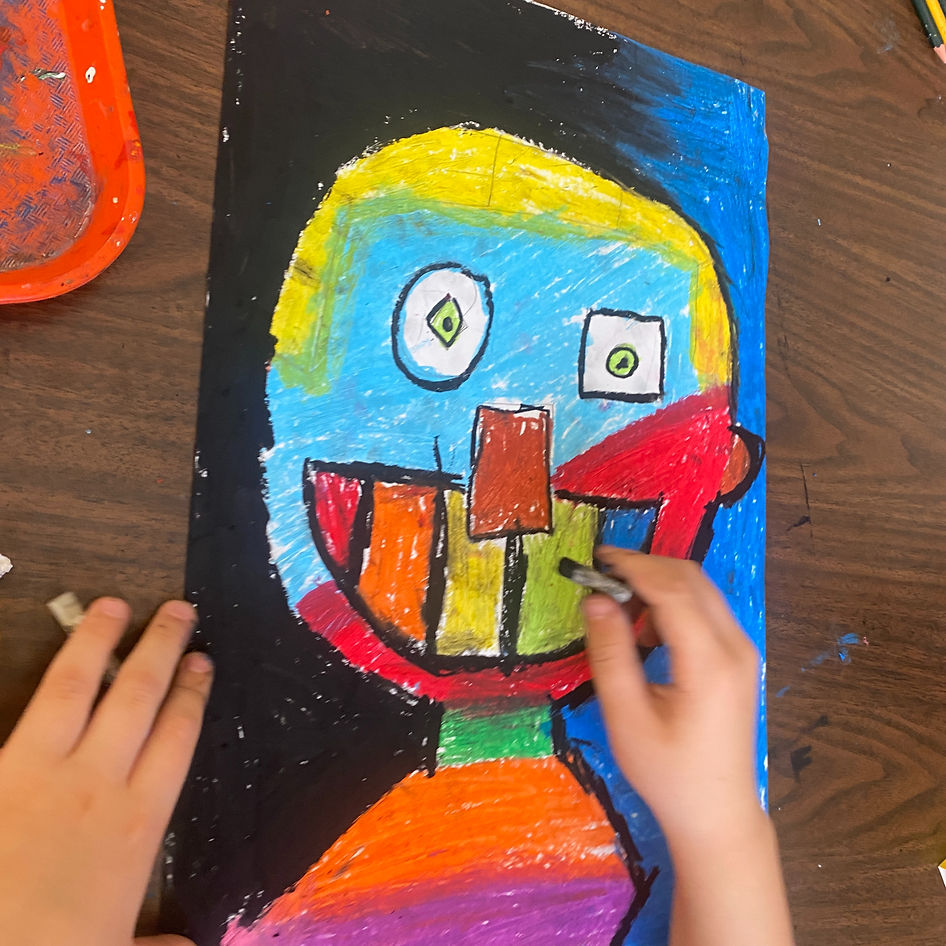
5/31/24
Arts Education Resources
Learning Resource: Cubist Self Portraits
by Noormah Jamal, CMA Artist in Residence 2023-24, in collaboration with 5th graders at Children’s Workshop School, NYC
Click to expand media gallery.
View, Download, & Discover More!
While self-portrait exercises are traditionally based on observation and realism, this class is devoted to breaking the traditional portrait into shapes and simpler forms. Students will discover the art movement Cubism and the powerful visual techniques it innovated.

Cubism was one of the most influential visual art styles of the early twentieth century. It was created by Pablo Picasso (Spanish, 1881–1973) and Georges Braque (French, 1882–1963) in Paris between 1907 and 1914. When looking at Cubist composition you may notice two things: 1) Simple shapes and forms 2) Multiple perspectives. Seemingly familiar subjects like people or objects found in the home (newspapers, breakfast or a guitar) take on a new life and character. Through Cubist techniques, they emphasized the two-dimensional flatness of the canvas instead of creating an illusional space. Rather than copy nature, it aspired to show more. What kind of visual games can you create?

Learning Objectives:
Composition and placement are key to this assignment.
Introduction to single and multiple point perspective.
Participants should be able to compose basic shapes into a portrait.
The size of the portrait should also be well composed on the drawing paper.
Confidently use and blend oil pastels
Materials:
Pencils
Oil pastels
Mixed media
Paper
Eraser
Ruler
Looking at Cubist Art:
Pablo Picasso (Spanish, b 1881–d. 1963) Bottle of Vieux Marc, Glass, Guitar and Newspaper. 1913, Tate © Succession Picasso/DACS 2024 (LINK)
Juan Gris (Spanish, b. 1887–d. 1927) Juan Legua. 1911, oil on canvas, Jacques and Natasha Gelman Collection, Metropolitan Museum of Art, NYC (LINK)
Sonia Delaunay (French, born Ukraine, b.1885 –d. 1979) Simultaneous Dresses (Three Women, Forms, Colours) 1925 Oil on canvas. Museo Nacional Thyssen-Bornemisza, Madrid (LINK)
David Hockney (British, b. 1937) Nicholas Wilder Studying Picasso.1982, composite polaroid, Private Collection, Courtesy David Hockney Foundation (LINK)
Step 1: Looking at history
Following the principles of Look, Make, Share, begin by introducing the class to the Cubist art movement. Share examples across culture and time.
Step 2: Introduction to materials
Provide students oil pastels and encourage them to explore how they blend and mix differently than colored pencils. Use fingers, q-tips, cloths and found materials with different weights to show how colors can mix on the paper. Demonstrate how oil pastels can also be used to create high-contrast sharp lines.
Step 3: Exploring perspective + shapes
A Cubist portrait shows different views of subjects using multiple perspectives rather than the single perspective we’re accustomed to. If you look in the mirror you see your face frontally, imagine looking to the right just slightly - what comes into your vision, and what do you lose? Try again a little further to the right. What now? Try drawing each visual addition you see each time you move a little further to the right. Repeat on the left side. The Elements of Art we explore today include Shape, color, line, space, and form. The Principles of Art are contrast, proportion, and perspective.
Step 4: Presentation
A critical part of the class is sharing the work we made and sharing feedback. How did other students explore the material? Do we recognize familiar themes or subjects?
While looking at examples of Cubist Art and while creating your composition, consider the following questions:
Does a portrait need to look like the subject?
Have you ever seen artworks like these before? Do they remind you of anything?
What types of shapes and lines will you use to create your portrait?
Is a Cubist portrait more true to life than a traditional portrait?
Instructor Notes:
Likeness to oneself is encouraged but not the goal of this assignment. Composing various shapes and geometric forms to make a portrait is the goal. Participants should be able to think outside of the box and think of image-making outside of the standard 'drawing' or 'realism'. Think of the space behind the portrait, think of drawing at its most simplified form. Critical Reflections: This class went well. They were excited to be working with oil pastels. With support, some should start using oil pastels differently than how they would use crayons, including pressure applications including smudging, blending, and sgraffito.
Examples of student work:









































